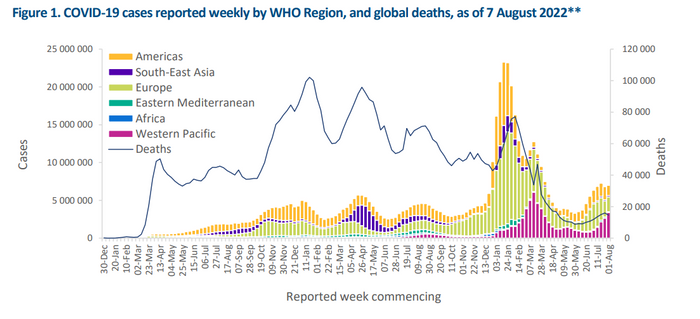The global tally of new COVID cases was stable in the week through Aug. 7 from the previous week, while the number of fatalities fell by 9%, according to the World Health Organization.
In its weekly epidemiological update, the agency said more than 6.9 million new cases were reported in the week and over 14,000 deaths were recorded.
On a regional basis, cases rose 29% in the Western Pacific region, but fell or remained steady in the African Region, by 46%, the Region of the
Americas, by 22%, the Eastern Mediterranean Region, by 22%, the European Region, by 7%, and the South-East Asia Region, by 3%.
The highest number of new cases was recorded in Japan, at 1.49 million, and the U.S., at 759,806. The WHO again cautioned that the numbers should be viewed carefully, as changes in testing strategies mean far fewer tests are being performed and consequently far fewer positive outcomes are being recorded.

Source: World Health Organization
The omicron subvariant BA.5 continued to become dominant, accounting for 69.7% of all sequences submitted to a central database, up from 68.9% a week ago.
“BA.5 descendant lineages (BA.5.X) are increasing in diversity, with additional mutations in spike and non-spike regions,” said the update. “WHO continues to monitor all lineages, including descendant lineages of [variants of concern], to track an increase in prevalence and change in viral characteristics.”
U.S. known cases of COVID seem to be declining based on numbers provided by a New York Times tracker, although the true tally is likely higher given how many people are testing at home, where the data are not being collected.
The daily average for new cases stood at 109,117 on Tuesday, according to the New York Times tracker, down 15% from two weeks ago. The daily average for hospitalizations was down 2% at 42,868, while the daily average for deaths is up 13% to 490.
Cases have been falling since mid-July in more than half of all states, and in the others the increases are modest. Only Iowa and Pennsylvania are showing cases up more than 20% in the last two weeks. Puerto Rico’s average case tally is up 14% in the period, Oklahoma is up 12%, Rhode Island is up 11%, and North Carolina and Minnesota are up 10%.
Coronavirus Update: MarketWatch’s daily roundup has been curating and reporting all the latest developments every weekday since the coronavirus pandemic began
Other COVID-19 news you should know about:
• Australia is decommissioning a CovidSafe app because it’s no longer being used for contact tracing, the Guardian reported. The app cost about $75,000 a month to run and was touted by ex–Prime Minister Scott Morrison. The health minister, Mark Butler, said in a statement that “this failed app was a colossal waste of more than $21m of taxpayers money.” Butler revealed that CovidSafe “only found two unique positive COVID cases at the cost of more than $10m each.” He said it’s “clear [that] this app failed as a public health measure, and that’s why we’ve acted to delete it.”
• The Associated Press is reporting on how young Chinese graduates are struggling to find jobs as anti-COVID measures are forcing factories, restaurants and other employers to close. Liu Qian, job hunting armed with a new master’s degree, said two employers interviewed her and then said the positions had been eliminated. Others asked her to take lower pay. Liu, 26, said some employers balked when she asked for a monthly salary of 8,000 yuan ($1,200). The average graduate last year was paid the equivalent of 9,800 yuan ($1,500) per month, according to Liepin, a job-hunting platform.
• China is racing to test thousands of tourists in Tibet and Hainan and close venues to rein in a fresh outbreak of COVID cases driven by the omicron variant, the Guardian reported. Mainland China reported 828 new domestically transmitted cases across more than a dozen provinces and regions for Aug. 8, with more than half of them in Hainan, a popular tourist destination, official data showed on Tuesday. Tibet, which until now had reported only one symptomatic case since the pandemic started more than two years ago, has also reported cases.
• An international team of scientists identified a new virus that was likely to have been transmitted to humans after it first infected animals, the Washington Post and other media outlets reported. The Langya virus was observed in 35 patient samples collected in two eastern Chinese provinces. The cases may be yet another zoonotic spillover to humans.
Here’s what the numbers say
The global tally of confirmed cases of COVID-19 topped 586.5 million on Wednesday, while the death toll rose above 6.42 million, according to data aggregated by Johns Hopkins University.
The U.S. leads the world with 92.3 million cases and 1,034,654 fatalities.
The Centers for Disease Control and Prevention’s tracker shows that 223 million people living in the U.S. are fully vaccinated, equal to 67.2% of the total population. But just 107.5 million have had a first booster, equal to 48.2% of the vaccinated population.
Just 20.6 million of the people 50 years old and over who are eligible for a second booster have had one, equal to 32% of those who had a first booster.


